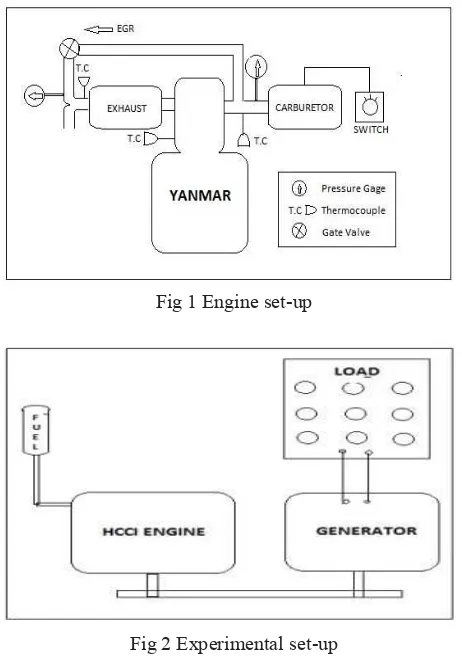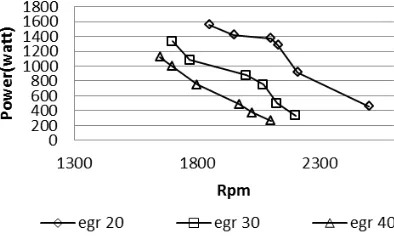The influence of intake pressure and EGR in the
combustion timing of a gasoline fuelled HCCI
engine developed from single cylinder CI engine
Witantyo
*, Ardi Nugroho
*, Septian Surya Dani
* *Mechanical Engineering ITS, Surabaya, Indonesia
witantyo@me.its.ac.id, ardi09@mhs.me.its.ac.id, mbah_sep@yahoo.com
Abstract — The study is aimed to obtain suitable methods in
controlling the combustion timing of Homogeneous Charge Compression Ignition (HCCI) engine. HCCI is a combustion technology alternative that has potentials to obtain higher efficiency with lower exhaust emissions. For that, a single cylinder CI engine was modified into a gasoline fuelled HCCI engine and coupled with an appropriate dynamometer. The accuracy of the timing was evaluated by measuring the engine torque generated. The experimental variables are the percentage of exhaust gas recirculation and inlet pressure variations as a replacement for compression ratio variation. Fuel-air mixture is maintained at stoichiometric. Results indicate that timing of HCCI combustion could be regulated by both methods. Intake to control the HCCI engine load.
Key words - HCCI engine, combustion timing, variable compression ratio, intake pressure, EGR.
I. INTRODUCTION
Currently Internal Combustion Engine still plays an important role in our lives, especially in the transportation sector. In Indonesia, most of the existing transportation vehicles use Spark Ignition (SI) or Compression Ignition (CI) Engine. SI has the disadvantage of low thermal efficiency because the number of wasted heat while CI has better thermal efficiency than SI but emissions of NOx and particulate matter is still poor. To improve the efficiency of the engine, since about 10 years ago some researchers began to notice the potential of Homogenous Charge Compression Ignition (HCCI) engine. HCCI is expected to have a higher efficiency with lower emissions.
The principle of the HCCI combustion is fuel mixture ignited by itself (auto-ignition) as in the CI. But, fuel and air are mix to a stoichiometry homogeneous mixture at the suction stroke and the mixture is ignited by high temperature rise of compression stroke. The homogeneous mixture makes combustion occurs more uniform and cleaner without Soot and NOx. However, HCCI combustion is facing handicap of difficulty to control combustion timing. There is no direct method to control the start of combustion. The start of
combustion is dictated by the auto-ignition chemistry of the fuel air mixture exposed to the temperature rises in the compression stroke. Stanglmaier et.all (1) identifies combustion timing of HCCI is affected by auto-ignition properties of the fuel, fuel concentration, residual rate, mixture homogeneity, compression ratio, intake temperature, engine temperature and other engine-dependent parameter. Beside the fuel properties, basically combustion timing in HCCI engine is highly dependent on the pressure and the combustion chamber would vary as desired.
This experimental study investigates the influence of compression ratio and residual rate to control the combustion timing of HCCI engine. An HCCI engine was developed based on a diesel engine. Variation of compression ratio was selected to be 18, 19 and 20 based on the auto-ignition temperature of the gasoline mixture used. However, it is difficult to make a variable compression ratio engine. Therefore, compression ratio variation was done by installing a throttle valve in the intake pipe to regulate intake pressure to the desired compression ratio. To determine the compression ratio corresponding to the intake pressure changes, an Adiabatic Compression equation 1 is used to create table 1.
……… (1)
Table1. Compression ratio corresponding to the intake pressure changed
Another way in order to control the combustion timing is by using Exhaust Gas Recirculation (EGR) to vary the residual rate. EGR is used to limit the amount of fuel mixture into the combustion chamber so that some space in the
Page 409 of 436
combustion chamber filled by exhaust gas. The presence of exhaust gases in the combustion chamber will cause a slower and retarded combustion. The EGR would be varied to 20%, 30%, and 40% of the valve opening approximate to similar volume percentage.
II.ENGINE AND EXPERIMENTAL SET-UP
The experiment was done in Combustion Laboratory, Mechanical Engineering, ITS. Figure 1 shows the engine set-up and figure 2 shows the experimental set-set-up. Data noted includes the intake pressure, exhaust pressure, intake temperature, exhaust temperature and engine temperature. The parameters changed are the pressure of the intake pipe and the percentage of EGR. Intake pressure variation used is 0, - 5 and - 10 cmHg. Intake pressure regulation is done by regulating the throttle opening is connected to the switch. This switch can be set to the desired pressure is obtained by looking at the value of the pressure on the Pressure Gage. The second parameter used is the percentage of EGR. Setting is done by adjusting the EGR valve.
Fig 1 Engine set-up
Fig 2 Experimental set-up
Developing HCCI engine requires some experimentation with various failures. The engine modified is a Yanmar L48N 210 cc diesel engine with 1:20 compression ratio and 70mm bore x 57mm stroke. To measure the performance of the engine, an electric generator is coupled to the engine by using belt and pulleys. The principle of this HCCI engine testing is
by converting the power generated by the engine into electrical power so that can be measured easily. The generator is connected to a load bank. The data taken in this experimentation are current and voltage produced by the generator and the fuel consumption of the engine.
III.RESULT AND DISCUSSION
Results of the experiment are divided by variation in compression ratio which is corresponding to the intake pressure, variation in EGR, and combination of both.
A. Variation in compression ratio at 20% EGR
HCCI engine experimentation here is different with conventional engine such SI or CI. Figure 3 shows the decreasing trend of power at higher engine rotational speed. This is happen because the rotational speed of the engine can only be regulated by the load. Power dependents to speed and there is no other means to regulate the power and speed like in the conventional engine. The higher the speed, the greater the friction generated, and lower the power generated.
Fig 3 Power vs Rpm of the engine at different intake pressure
Other interesting finding is that maximum engine power generated at intake pressure of - 5 cmHg. Supposedly, power would be higher at higher compression ratio corresponding to the intake pressure. At the intake pressure of - 10 cmHg, power generated by the engine is smallest; at the intake pressure of - 5 cmHg, power generated is increased; but then, at the intake pressure of 0 cmHg power generated is reduced. The reason behind this finding is that at higher intake pressure (0 cmHg) the pressure and temperature inside the combustion chamber is increasing higher at the compression stroke. This would ignite the mixture earlier that might be too advanced so that the pressure energy produced by the combustion would slightly counterattack flywheel energy at the compression stroke of the engine.
Figure 4 shows Specific Fuel Consumption (SFC) of the engine at different intake pressure. It is usual to see that all the three different curves resemble into one curve that shows the SFC will be reduced at higher power generated. Figure 5 show that this HCCI engine at the best is only delivering 0.4 kg fuel per kWh of energy. This record is not low enough and is only comparable with ordinary SI engine working at approximately
Page 410 of 436
30% efficiency due to pumping losses created by throttle valve in the intake pipe.
Fig 4 Specific Fuel Consumption (SFC) of the engine at different intake pressure
Fig 5 Specific Fuel Consumption (SFC) vs Rpm
B. Variation in EGR at compression ratio1:19
Dissimilar to the compression ration variation, EGR variation shows linear trend that gives less power generated to the more exhaust gas recirculated. Figure 6 shows clearly the effect of EGR in power regulated, higher EGR produce less power of the engine. The graph shows maximum power produced at 20% EGR which generates 1.5 kW of power at 1850 rpm. This is higher than at 30% EGR which only produces 1.3 kW at 1700 rpm and at 40% EGR that produces 1.1 kW at 1650 rpm. Reduction in power is caused by volume reduction of fresh fuel air mixture sucked by the engine. This is to prove that EGR is a suitable way to control power of the HCCI engine.
Fig 6 Power vs Rpm at different EGR rate
To determine the HCCI engine working envelope then there is a need to create a figure to combine all results of the HCCI engine testing. With many varieties of combustion pressures and EGR rate obtained in the HCCI engine experimentation, this envelope would shows the area of HCCI engine working limit. Figure 7 shows the working area of this HCCI engine. The lower limit range of HCCI engine operation is about 1400 rpm which is generated when EGR rate is 40% at -10 cmHg intake pressure. Intake pressure less than -10 cmHg at more than 40% EGR will fail combustion process in the engine (miss-firing). This happens because the smaller fuel mixture energy sucked into the combustion chamber and also lower temperature generated inside the combustion chamber; then miss-firing will happen.
The upper limit range of the HCCI engines operation is about 2500 rpm at -5 cmHg intake pressure and 20% EGR rate. This upper limit shows the highest rpm at medium intake pressure and the smallest EGR before knocking. EGR rate cannot be lesser than 20% and intake pressure variation cannot be more than -5 cmHg to assure no knocking appear in the engine that will broke the crankshaft. Reducing EGR rate to obtain a higher rpm than 2500 may not be attained because the knocking occurs. Effort to reduce the EGR to get higher rpm has similar effect to the increasing intake pressure more than - 5 cmHg. The knocking that occurs in the combustion chamber would work against the force of compression.
Fig 7 Power vs Rpm at different Compression ratio and EGR rate.
V. CONCLUSIONS
Five main results from this preliminary research of the HCCI engine have been established. First, a workable HCCI gasoline engine has been developed by modifying the fuel supply system of a single cylinder diesel engine. Second, varying intake pressure was proven to be a mean to control the engine combustion timing as long as engine compression ratio is not too high. Third, varying EGR rate was also proven to be a mean to control the engine combustion timing. Fourth,
Page 411 of 436
HCCI combustion has the potential to increase engine efficiency at lower Soot and NOx formation; however, the engine has only a very narrow working envelope due to miss-firing or knocking. Fifth, maximum power generated by an HCCI engine is lower than a SI or even a CI engine with similar sweep volume.
ACKNOWLEDGMENT
This research was supported by LPPM-ITS and Research Alumni ITS as a part of searching for higher efficiency engine development project for Sapuangin team.
REFERENCES
[1] R.H.Stanglmaier, C.E.Robert, Homogeneous Charge Compression Ignition (HCCI): benefit, compromise, and future engine application., SAE paper, 1999- 01-3682, 1999.
[2] B.Johansson, Homogeneous Charge Compression Ignition-the future of IC Engines. Lund Institute of Technology at Lund University, 2005 [3] R.Johansson, B.Daniel, M.Karlsson; K.Ekholm, P.Tunestal, HCCI
Engine Modeling and Control using Conservation Principles, SAE paper. 2008-01-0789, 2008
[4] P.Kumar, S.Sooraj, V.S.Murugan, Homogeneous Charge Compression Ignition Engine, International Journal of Scientific & Engineering Research 4, ISSN 2229-5518, 2013.
[5] M.Yao, Z.Zheng, H.Liu, Progress and Recent Trends in Homogeneous Charge Compression Ignition (HCCI) Engines, Tiajin: Tianjin University, 2009
[6] H.Zhao, HCCI and CAI engines for the automotive industry, Woodhead Publishing in Mechanical Engineering, 2007

